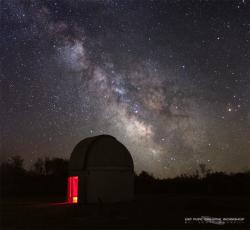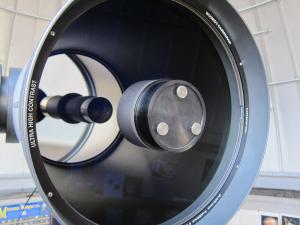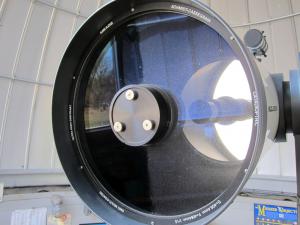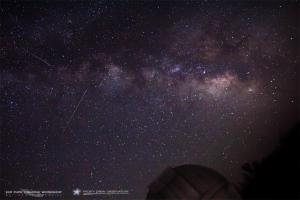
Public Stargazing
- Where:
- Frosty Drew Observatory
- When:
- Friday May 2, 2014 at 8:00 p.m.
- Cost:
- $1 Suggested Donation per Person
Tonight's weather forecast is calling for partly cloudy to mostly clear skies with breezy conditions. The 16% waxing crescent Moon will set at 11:00 p.m. offering us a stunning view of the slim crescent phase. Additionally, when the Moon is in such a slender fashion, earth-shine will be strikingly visible. Earth-shine is the result of sunlight reflecting off the Earth and illuminating the shadow side of the Moon. After the Moon sets, super dark skies will remain. With the early setting crescent Moon and the minimal cloud cover, we could be setup for an awesome night of stargazing! The mesmerizing summer Milky Way will rise at midnight, becoming visible between midnight and 2:00 a.m. accompanied by some Eta Aquarid meteors passing overhead. Tonight will likely be our first view (and photo) of the Milky Way's Sagittarius arm and bright central bulge. To top off this most excellent prospect of celestial awesome, tonight will be the first night operating with a newly cleaned corrector plate on the telescope which should significantly boost the clarity of our views in the telescope. We plan to open at 8:00 p.m. with views of the Moon, Jupiter, Mars, and eventually Saturn. If skies stay clear, tonight is your night to be at Frosty Drew Observatory!
-------------------------------------------------------------------------
Weekly Happenings
Scott MacNeill
This past year at Frosty Drew Observatory we have noticed a deficiency in the operating quality of our primary 16” telescope. We first starting noticing this decrease in quality early last Summer which kick started our troubleshooting and evaluation of the telescope's operations. After much debate, troubleshooting, and speculation we came to the conclusion that the likely problem was that the lens at the front of the telescope's aperture, called the “Corrector Plate”, needed cleaning. The corrector plate is the most vulnerable part of the telescope to dust collection as it always points towards the sky. Being in Ninigret Park places us about 1/4 mile from the salt pond and about 1 mile from the ocean itself. So we have a significant amount of salt in the air that settles on the corrector plate as well. Add in the obscene amount of pollen that plagues most New England breathers and we have a nasty mix of quality degrading deposits taking up residency on our lens. Well last weekend we decided to evict these elusive eye candy thieves. Once the cleaning process was underway, it became quite apparent at how dirty the lens actually was. We spent the better part of an afternoon working on the lens and once completed, we were stunned at the visible clarity of the lens. 
Of course, as Murphy's Law states, rain and clouds would keep us from having any chance to test the optics under the night sky all week. Though a quick break in the clouds last Friday offered us a preview of what to expect. I did some research through the collection of astronomer journals at Frosty Drew and did not find any mention of a previous cleaning. If any readers know of the last date the corrector was cleaned, please send us a reply (Joe H., Doug S., Ernie E.?). Tonight is the first real test and we are hopeful that the viewing quality of the primary telescope will be even more spectacular than views of late!
This coming Tuesday (May 6) during the early morning hours before dawn, the Eta Aquarid Meteor Shower peak will happen. The Eta Aquarids are the second notable meteor shower of the Spring season. Originating from Halley's Comet, the Eta Aquarids favor southern hemisphere stargazers with a projected rate of up-to 40 meteors per hour, with northern hemisphere meteor watchers setting expectations upwards of 10 meteors per hour. This year the Moon is placed well for Eta Aquarid watching! Setting at 1:00 a.m., the Moon will not obscure our view of meteors. Additionally, since the Moon will not be present and the Milky Way is rising earlier every night, we will have a stunningly beautiful view of the bright Sagittarius arm stretching out from the center of the galaxy during the meteor shower. Which also makes this a very photogenic meteor show (photo-op anybody?). Frosty Drew does not officially plan to open for the Eta Aquarid shower, though we will surely be on site if weather conditions are favorable. If meteor watching is your digs, stop in at Frosty Drew Observatory from midnight until dawn and take advantage of the super dark, wide open skies of Ninigret Park. The Eta Aquarids have a wide peak period with meteors becoming visible days ahead of the peak. Keep a sharp eye out tonight for any early Eta Aquarid meteors at Frosty Drew!
Take some time this Spring to check out the amazing views we have of the cosmos here on planet Earth!
-Scott


